MONTRÉAL PHOTOSTEREOSYNTHESIS: L'ARRIVÉE D'UN TRAIN À LA CIOTAT
PRODUCTION & INSTALLATION PROPOSAL
Garnet Hertz, 05 June 2009
A printer-friendly PDF file of this proposal is available at http://www.conceptlab.com/photostereosynthesis/hertz-montreal-photostereosynthesis-proposal.pdf (17.3M Adobe Acrobat file).
Photostereosynthesis - Overview
This project excavates photostereosynthesis, a lost imaging technology developed by the co-inventor of contemporary cinema, Louis Lumière. This imaging technology, released in 1920, produces dimensionally deep and multi-layered images through a series of stacked photographs. In this process, individual frames are shot at extremely small depths of field (wide aperture) at incrementally increasing focal lengths (focus pull), which has the effect of "depth-slicing" of a dimensional space with the help of focus. Each individual exposure is printed as a transparent positive on glass and stacked to produce a composite 3D photo with the scene "entombed" in a translucent image several centimeters thick. The resulting composite image is somewhat similar to a hologram but is a physically volumetric representation.
Historiographically, this project proposes that Lumière's primary interest in the invention of cinema over two decades before was the exploration of depth, not movement. In other words, the dimensionality of photostereosynthesis (1920) is used to speculate whether Louis Lumière's goals in the invention of cinema (1895) was to primarily capture a sense of three dimensional space as opposed to a moving two dimensional image. This work does not present this as a fact, but explores it as a historical, technological and social potential. As media archaeology, it digs back into time and revises history to tell a narrative of photostereosynthesis and cinema being developed concurrently.
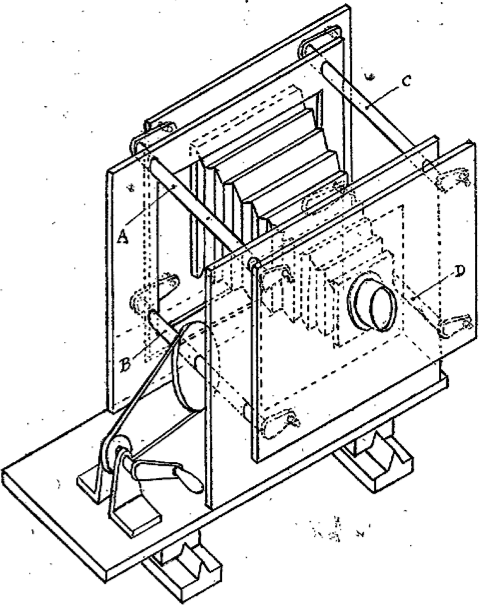
Diagram of original photostereosynthesis camera. For more information on the original imaging system, see Louis Lumière, Représentation photographique d'un solide dans l'espace. Photo-stéréo-synthèse, Académie des Sciences, November 8th 1920 (452K PDF). A contemporary re-creation of this camera system can be seen at http://conceptlab.com/photostereosynthesis/cameracontroller.html.
Montréal Photostereosynthesis - Project Overview
This project will investigate the location of the first film screening in Canada on June 27 1896, which occurred in the Palace Theatre on the corner of Boul. Saint Laurent and Viger in downtown Montréal. The original film screenings at the Palace Theatre included one of the Lumière brothers' most prominent early films, the 50 second L'Arrivée d'un train à La Ciotat, a one-shot film of a steam train arriving at the train station of the French coastal town of La Ciotat. The film is associated with an urban legend in the world of cinema, in which when the film was first shown to an audience that individuals jumped from their seats in fear because they were afraid of the life-sized moving locomotive coming toward them (see Martin Loiperdinger's "Lumiere's Arrival of the Train: Cinema's Founding Myth" in The Moving Image: Volume 4, Number 1, Spring 2004, pp. 89-118). This project will combine the dimensionality of this film with the dimensional nature of Louis Lumière's later photographic invention, photostereosynthesis.
The original building of the first film screening in Canada is still standing and currently is occupied by a restaurant, an audio boutique and an import/export business. It is proposed that this location is visited and explored through a custom photostereosynthesis camera system and that the dimensional images acquired from the location be incorporated into an installation project. (For a detailed description of this custom digital SLR camera system, see http://conceptlab.com/photostereosynthesis/cameracontroller.html.)

Account of the Cinématographe Lumière first Montreal screening, La Patrie, 29 June 1896, p. 4
In addition to investigating the location of the first film screening in Canada, this project will also use original footage from the first screening in Montréal. This project will take one of the first films by the Lumière brothers (L'Arrivée d'un train à La Ciotat, which was also shown in Montréal at the Palace Theatre) and develop and explore it as a 3D entity as if photostereosynthesis (1920s) existed when the film was produced in 1895. The project will explore the film in terms of its depth and spatiality... if it was shot as a moving image with depth.
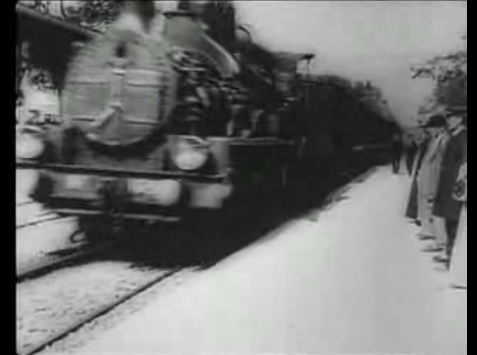
A video of L'Arrivée d'un train à La Ciotat can be seen online at http://www.youtube.com/watch?v=2cUEANKv964
Montréal Photostereosynthesis - Installation Description
The installation is envisioned as having two main components:
-
Taking one of Lumière brothers' first films (L'Arrivée d'un train à La Ciotat) - and one of the first films shown in Canada - and converting it to a three dimensional video or spatial image within a gallery installation. At this point, it is proposed that the film be projected on a non-flat screen or as a single still frame photomural (see image below).
-
Within the context of Montréal, this project will investigate the location of the first film screening in Canada on June 27 1896. This first Lumière Cinematographe screening occurred in the Palace Theatre on the corner of Boul. Saint Laurent and Viger in downtown Montréal. This original building is still standing and currently is occupied by a restaurant, an audio boutique and an import/export business (see photos below). It is proposed that people or objects in this current building location are rephotographed in the style of photostereosynthesis, and that these images are incorporated into the exhibition installation.
Montréal Photostereosynthesis - Installation Diagram
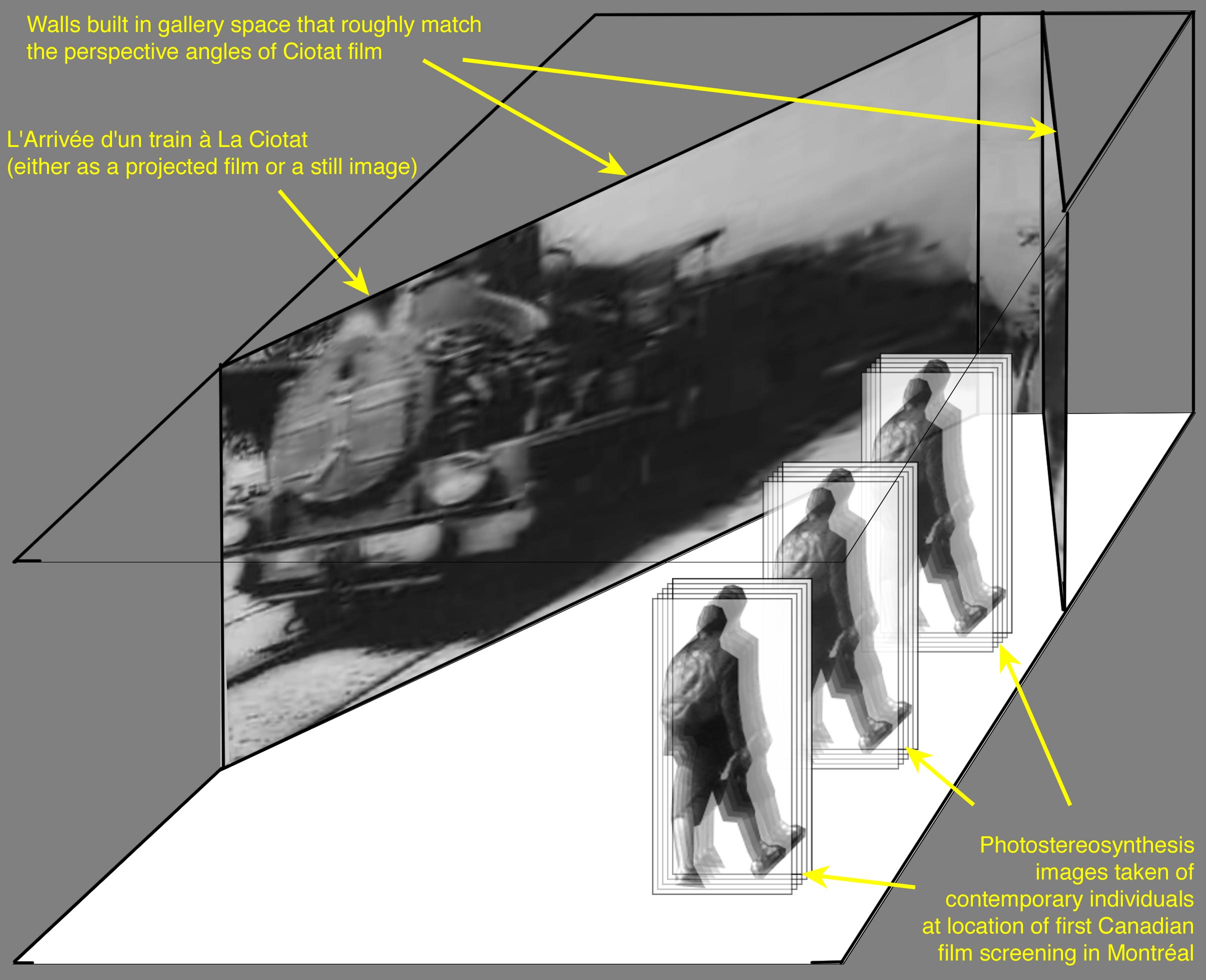
Diagram of the installation, including three life-sized panels of individuals photographed with the photostereosynthesis camera system on the right of the installation space, and a projection or photomural of L'Arrivée d'un train à La Ciotat displayed on a angular screen. (For a larger image, see http://www.conceptlab.com/photostereosynthesis/img/diagram-train-labelled.jpg.)
Diagram of Photostereosynthesis Print
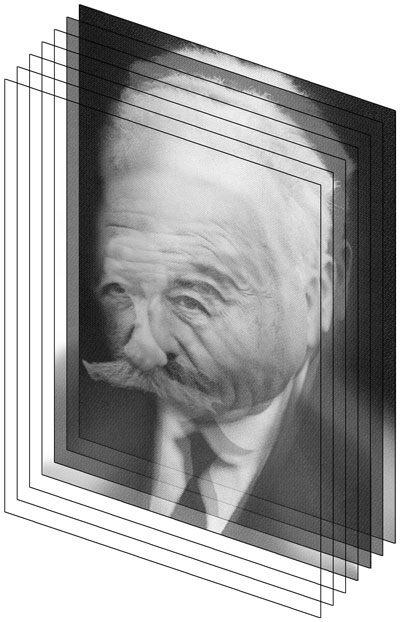
Detail of how the photostereosynthesis images are printed. By using a custom camera system, this technique produces a multi-layered image constructed of several transparent exposures. The composite image is a dimensionally thick object, with the appearance of the individual being 'entombed' inside. The three life-sized panels of contemporary individuals (taken near the corner of Boul. Saint Laurent and Viger) will be printed with this technique.
Montréal - Location of First Film Screening in Canada
"the first film screening [in Canada] was actually held in Montreal on June 27, 1896. On that date, Louis Minier and his assistant Louis Pupier projected animated views using a Cinematographe Lumière at the Palace Theatre, located on 78 St. Lawrence Boulevard (this building, on the corner of Viger, is still standing)" (Source: http://www.cinemamuetquebec.ca/content/theme_cap/55?lang=en)
It is proposed that contemporary individuals from this building location be photographed in the style of photostereosynthesis, and that these dimensional images are printed life-size and incorporated into the exhibition installation.
Details of the location of the first film screening in Canada is as follows:

Location of first Lumière Cinématographe screening in Canada on June 27 1896, at the corner of Boul. Saint Laurent and Viger, Montréal.
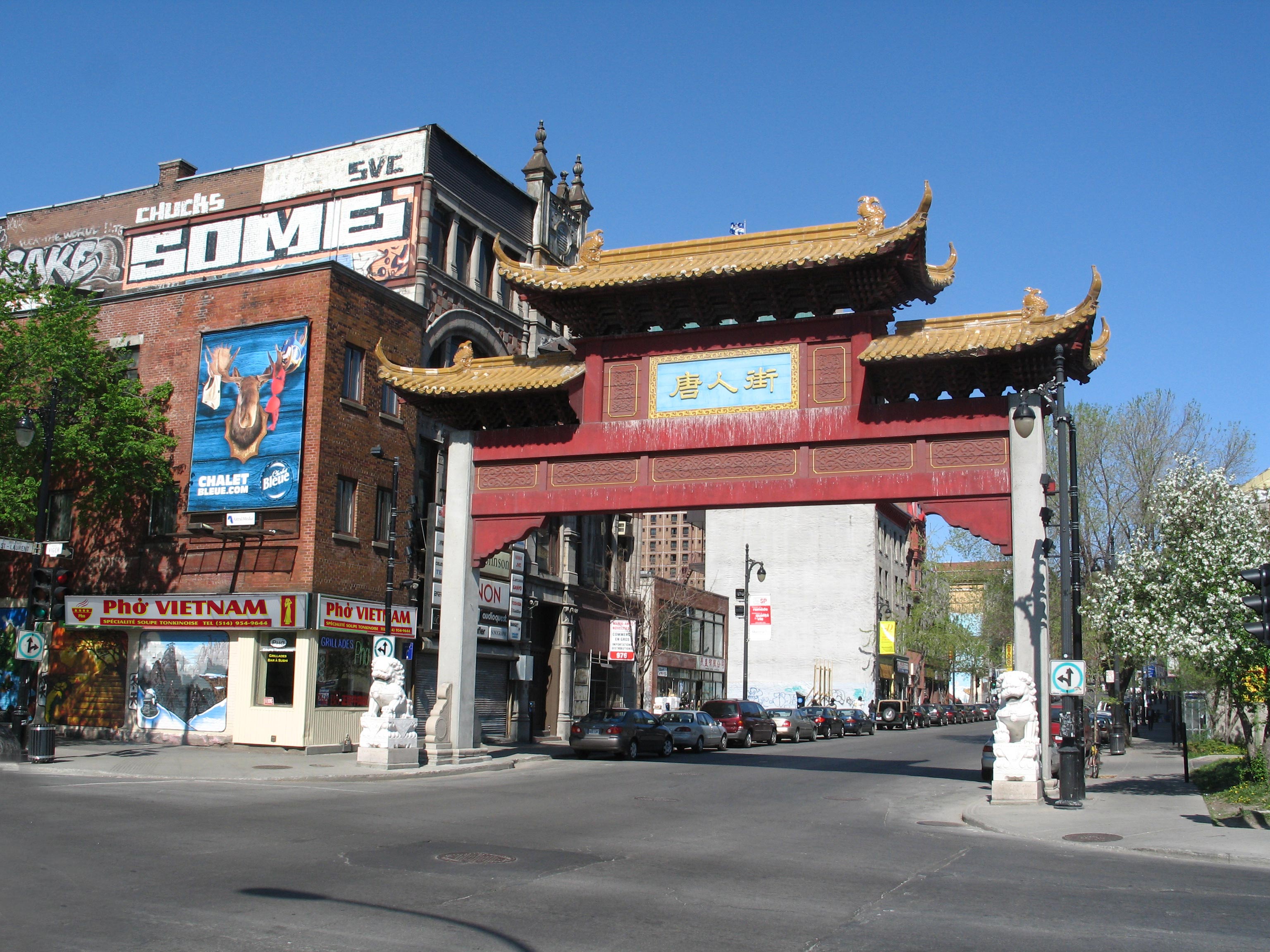
Contemporary photograph of corner of Boul. Saint Laurent and Viger, location of first Lumière Cinématographe screening in Canada on June 27, 1896.
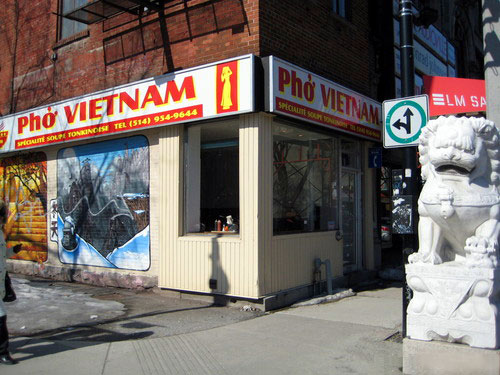
Contemporary photograph restaurant at corner of Boul. Saint Laurent and Viger, location of first Lumière Cinématographe screening in Canada on June 27, 1896. Individuals within this restaurant or around this location will be photographed using the custom photostereosynthesis camera system and their images will be integrated into the L'Arrivée d'un train à La Ciotat installation.

Contemporary photograph of audio boutique near corner of Boul. Saint Laurent and Viger, location of first Lumière Cinématographe screening in Canada on June 27, 1896. Individuals within this business or around this location will be photographed using the custom photostereosynthesis camera system and their images will be integrated into the L'Arrivée d'un train à La Ciotat installation.
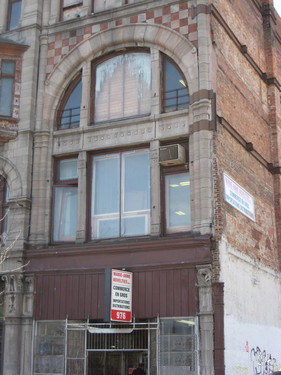
Contemporary photograph of import/export business near corner of Boul. Saint Laurent and Viger, location of first Lumière Cinématographe screening in Canada on June 27, 1896. Individuals within this import/export business or around this location will be photographed using the custom photostereosynthesis camera system and their images will be integrated into the L'Arrivée d'un train à La Ciotat installation.
Montréal Photostereosynthesis - Activity Timeline
During a four week residency in Montréal, activities would generally be as follows:
-
Week One: Interviewing and informally photographing individuals working or living around the corner of Boulevard Saint Laurent and Viger. This would include employees of the restaurant, audio boutique and the import/export business. During this process, I aim to obtain permission to formally photograph at least four (4) individuals.
-
Week Two: Photographing of the four (4) individuals in the style of photostereosynthesis. These photos would be full-body shots, with multiple exposures at extremely large aperture shot at varying focal lengths. For a detailed description of this custom digital SLR camera system, see http://conceptlab.com/photostereosynthesis/cameracontroller.html. Each individual will be photographed at approximately ten (10) separate depths of focus.
-
Week Three: Output of photographs of individuals will be made onto large format inkjet transparencies. The three (3) best individuals will be printed. The approximate size of each print will be 200 cm x 50 cm, and approximately ten (10) layers will be printed per individual. With ten layers and three individuals, there will be thirty (30) transparent prints at a size of 200 cm x 50 cm. The total printing area will be approximately 30 square meters.
-
Week Four: Experimentation with different installation formats, primarily with different methods to hang and display the transparent images. Although sandwiching the prints between glass is an option, this method is expensive and difficult to transport. Alternate methods of displaying a stack of ten transparent images would be explored, including the construction of a removable aluminum frame clipped to the edges of the transparency.
-
If more time is available, this project will explore different wall structure shapes to project L'Arrivée d'un train à La Ciotat on to.
More Information
See http://www.conceptlab.com/photostereosynthesis/ for background, sketches, and other proposals related to this project
For a CV of Garnet Hertz, see http://www.conceptlab.com/garnethertz/
For an overview of other work by Garnet Hertz, see http://www.conceptlab.com/
[Garnet Hertz, 2009]